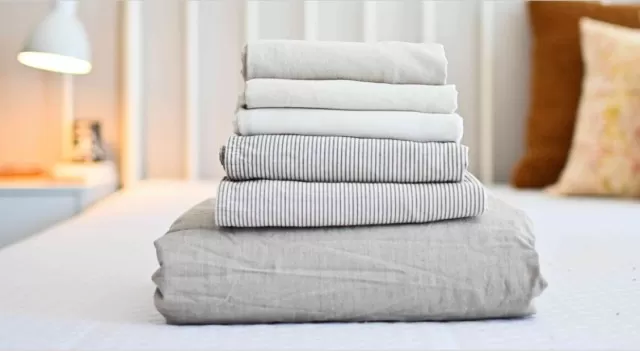Achieving clean and wrinkle-free bed sheets requires care and attention, you properly wash your sheets and enjoy cozy bedding for years to come.
Wash Bed Sheets

To wash sheets effectively, follow these guidelines:
It’s best to wash sheets separately from towels or clothing to allow them more room to circulate in the water, resulting in cleaner sheets.
Washing them alone also prevents damage from zippers and reduces pilling. If your washing machine has a center agitator, loosely form each sheet into a ball before placing it in the tub to minimize contact with the agitator.
Treat any stains on the sheets before laundering.
Avoid using bleach as it can harm the fabric. Instead, if you need to brighten white sheets, add 1/4 cup of lemon juice to the wash water.
For different Fabric Types like linen or silk, check the care label for any specialized detergent requirements.
Use a gentle cycle with cool or lukewarm water to wash the sheets.
Hot water is usually unnecessary unless sanitizing is required due to allergies or illness. Remove the sheets promptly after the cycle ends to minimize wrinkles.
You can also shake them out before putting them in the dryer to reduce wrinkles.
If possible, dry the sheets on an outside clothesline away from direct sunlight.
If using a dryer, choose a low heat setting to prevent damage from high temperatures. Remove the sheets from the dryer as soon as they are dry and fold them, smoothing out wrinkles by hand.
If wrinkles are set, you can add a damp towel to the dryer for an additional five minutes to add moisture and reduce wrinkles. Ironing the sheets should be avoided as high heat can damage the fibers.
For specific fabric types:
Silk Sheets:
Hand-washing is preferred, blotting with a towel instead of wringing.
If machine-washing, choose a delicate or hand-wash cycle in cool water using a mild detergent recommended for silk. Hang them to dry or use the lowest setting in the dryer.
Linen Sheets:
Linen can withstand higher washing temperatures (up to 104°F).
Use a mild detergent and avoid bleach. Linen dries quickly, so a hot or long dryer setting is not necessary.
Iron at the hot linen setting if desired.
Bamboo Sheets:
Use a mild laundry soap or one designed for natural products.
Avoid bleach or harsh cleaners. Wash on a gentle cycle, as some fading may occur initially.
Air-drying is preferred, but low or air-dry settings in the dryer can also be used.
By following these instructions, you can properly wash different types of bed sheets.
When to Wash Bed Sheets

To prolong the lifespan of your bed linens, it is recommended to wash your sheets every week, especially in humid climates where more frequent washing may be necessary.
Over time, dirt, dust, skin cells, body oils, and fluids, as well as fecal material, can accumulate on the sheets. The longer these particles remain on the fabric, the more strain is exerted on the fibers.
Additionally, skin cells, body oils, and fluids can attract microscopic mites.
To minimize the need for frequent washing, it is advisable to bathe before going to bed, as this will reduce the amount of dirt you carry into bed.
By keeping excess sweat, oils, and dirt out of your bed, you can keep your sheets clean for a longer duration. Having multiple sets of sheets available is also a good idea, ensuring that a clean set is always ready to be used.
By rotating three sets of sheets per bed, you can extend the lifespan of each set.
Store Clean Bed Sheets More Efficiently

Here are some suggestions on how to store clean sheets more efficiently.
To save time when making the beds, keep matching sheets together.
One option is to stash the folded sheet set inside one of its matching pillowcases, along with the second pillowcase. This method is suitable for linen closets or bedroom closets.
Another method is to place the folded fitted sheet and pillowcases inside the folded flat sheet just before its final fold.
This approach also helps in maintaining organization in linen closets or bedroom closets.
If you have a dedicated linen closet, you can store folded sheets in storage boxes labeled by size (such as twin or queen) or by room (e.g., primary bedroom).
However, keep in mind that this method requires extra space for the boxes.
Alternatively, you can utilize under-bed storage containers in the respective rooms where the sheets will be used.
This allows for convenient access and keeps the sheets neatly stored.
Editor’s Tip: For a fresh and clean scent, tuck a dryer bed sheet among the folded sheets.
*The information is for reference only.